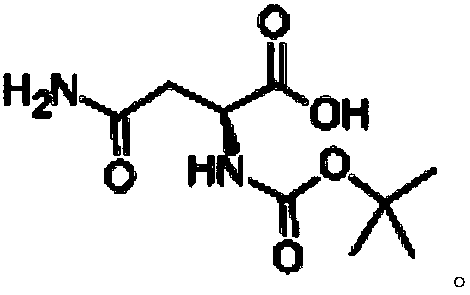A kind of preparation method of boc-l-asparagine
A technology of asparagine and asparagine, applied in the field of medicinal chemistry, can solve the problems of unfavorable industrialization, cost, environmental protection, high safety, cumbersome operation, etc., and achieve the effect of facilitating industrial production, high safety factor, and simple operation
- Summary
- Abstract
- Description
- Claims
- Application Information
AI Technical Summary
Problems solved by technology
Method used
Image
Examples
Embodiment 1
[0025] Prepare BOC-L-asparagine according to the following preparation steps:
[0026] Step (1), 150g L-Asn (1mol), 240g di-tert-butyl dicarbonate (1.1mol) and 700mL water are put into the 3L flask; , add dropwise the NaOH aqueous solution (3mol) of 300mL10mol / L while stirring, control the rate of addition, make pH=9~10, in this process L-Asn and di-tert-butyl dicarbonate are dissolved in water and react; Afterwards, the temperature was raised to 34° C., and then reacted for 4 hours under stirring;
[0027] Step (2), the reaction solution is cooled to less than 10°C with ice-brine; slowly add 6mol / L hydrochloric acid dropwise, keep the temperature below 10°C during the dropwise addition, acidify to pH 4.3, and precipitate BOC-L-asparagine crude product, Suction filtration, wash the solid with 150 mL of water, and dry the solid at 56°C to obtain 192 g of fine BOC-L-asparagine, with a weight yield of 128% (relative to L-asparagine), and a molar yield of 90.5%.
Embodiment 2
[0029] Prepare BOC-L-asparagine according to the following preparation steps:
[0030] Step (1), 150g L-Asn (1mol), 262g di-tert-butyl dicarbonate (1.2mol) and 700mL water are put into the 3L flask; , add dropwise the NaOH aqueous solution (3mol) of 300mL10mol / L while stirring, control the rate of addition, make pH=9~10, in this process L-Asn and di-tert-butyl dicarbonate are dissolved in water and react; Afterwards, the temperature was raised to 34° C., and then reacted for 4 hours under stirring;
[0031] Step (2), the reaction solution was cooled to less than 10°C with ice-salt water, and residual (Boc) was detected 2 O crystals; slowly add 6mol / L hydrochloric acid dropwise, keep the temperature below 10°C during the dropwise addition, acidify to pH 4.3, precipitate BOC-L-asparagine crude product, filter with suction, wash the solid with 110mL water, and dry the solid at 58°C After drying, 217.5 g of BOC-L-asparagine fine product was obtained, with a weight yield of 145% ...
Embodiment 3
[0033] Prepare BOC-L-asparagine according to the following preparation steps:
[0034] Step (1), 150g L-Asn (1mol), 218g di-tert-butyl dicarbonate (1mol) and 700mL water are put into a 3L flask; at a temperature of 25 to 30°C, while maintaining a rotational speed of 120 rpm, Add dropwise 300mL of 10mol / L NaOH aqueous solution (3mol) while stirring, and control the drop rate so that pH=9~10. During this process, L-Asn and di-tert-butyl dicarbonate are dissolved in water to react; the dropwise addition is completed Afterwards, the temperature was raised to 34° C., and then reacted for 4 hours under stirring;
[0035] Step (2), the reaction solution was cooled to less than 10°C with ice-salt water, and residual (Boc) was detected 2 O crystals; slowly add 6mol / L hydrochloric acid dropwise, keep the temperature below 10°C during the dropwise addition, acidify to pH 4.3, precipitate crude BOC-L-asparagine, filter with suction, wash the solid with 100mL water, and dry the solid at 5...
PUM
 Login to View More
Login to View More Abstract
Description
Claims
Application Information
 Login to View More
Login to View More - R&D
- Intellectual Property
- Life Sciences
- Materials
- Tech Scout
- Unparalleled Data Quality
- Higher Quality Content
- 60% Fewer Hallucinations
Browse by: Latest US Patents, China's latest patents, Technical Efficacy Thesaurus, Application Domain, Technology Topic, Popular Technical Reports.
© 2025 PatSnap. All rights reserved.Legal|Privacy policy|Modern Slavery Act Transparency Statement|Sitemap|About US| Contact US: help@patsnap.com


